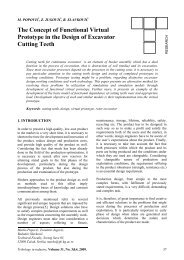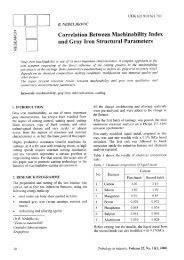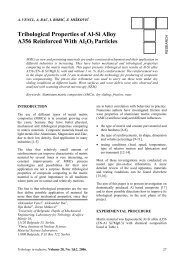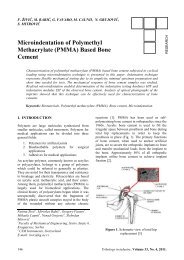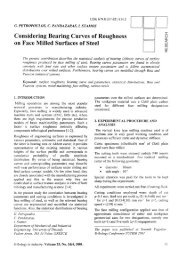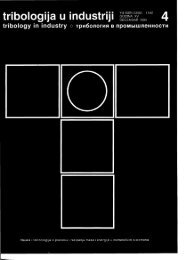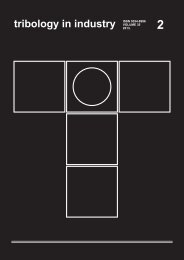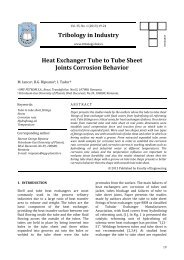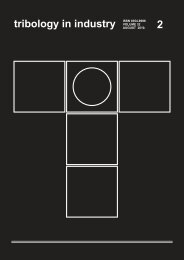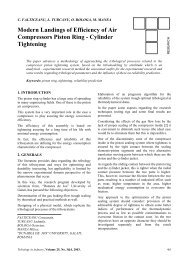Tribological Behavior of Thermal Spray Coatings, Deposited by ...
Tribological Behavior of Thermal Spray Coatings, Deposited by ...
Tribological Behavior of Thermal Spray Coatings, Deposited by ...
You also want an ePaper? Increase the reach of your titles
YUMPU automatically turns print PDFs into web optimized ePapers that Google loves.
A. Lanzutti at al., Tribology in Industry Vol. 35, No. 2 (2013) 113‐122coatings with the anti‐wear properties <strong>of</strong> the Nicomposite coating, highlighting the importantproperties <strong>of</strong> the composite coatings producedwith a simple and cheaper technique comparedto the thermal spray process.2. EXPERIMENTALa. Samples productionFor all types <strong>of</strong> the deposits ASTM 387 F22 steelplates (7×10 cm) and discs (d=5 cm) have beenused as substrates (chemical composition inTable 1).Table 1. Chemical composition <strong>of</strong> steel substrateASTM 387 F22.C Si Mn P Cr Mo Fe0.11 0.31 0.5 0.025 2.2 0.9 Bal.The thermal spray coatings have been depositedusing industrial procedures. The depositedcoatings were: NiCr 80/20 and NiCr 80/20 +Cr 2 O 3 deposited <strong>by</strong> APS (Air Plasma <strong>Spray</strong>)technique and WC CoCr 18/4 deposited <strong>by</strong> HVOFtechnique.Regarding the Ni matrix coatings, three types <strong>of</strong>deposits have been prepared: pure Ni (to beused as reference). Ni containing microparticles<strong>of</strong> SiC and Ni containing nanoparticles <strong>of</strong> SiC.The electroplating bath used was a high speednickel sulfammate plating bath having thefollowing composition: 500 g/l Ni(SO3NH 2 ) 2.4H 2 O, 20 g/l NiCl 2.6H 2 O, 25 g/l H 3 BO 3 , 1ml/l surfactant (CH 3 (CH) 11 OSO 3 Na basedindustrial product. The deposition was carriedout using a galvanic pilot plant (12 l platingtank) under galvanostatic control at 4 A/dm 2 ,50 °C, under continuous mechanical stirring.The deposition time was 2.5 h in order toobtain 70–80 μm thick deposits. For theproduction <strong>of</strong> the composite coatings 20g/l <strong>of</strong>micro‐ or nano‐powders were added into theelectroplating bath, dispersed usingultrasounds (200 W, 24 kHz) for 30 min andthen maintained in suspension undercontinuous mechanical stirring during theelectrodeposition. The micro‐particles have amean dimension <strong>of</strong> 2μm and a very irregularand sharp shape, while the nano‐particles havea mean diameter <strong>of</strong> 45 nm [21].b. Samples characterizationThe specimens characterization includesmicrostructure, chemical composition,microhardness, wear resistance at both roomtemperature and 300 °C and corrosionresistance in two different environments.The microstructure <strong>of</strong> the specimens have beenanalysed <strong>by</strong> SEM (Zeiss Evo‐40) + EDXS (Oxfordinstruments INCA) in cross section. Both the SiCcontent and the coatings’ porosity werecalculated using an image analysis s<strong>of</strong>tware [13].For nano composite coating The SiC content wasmeasured through the measurements <strong>of</strong> RFGDOES (HR‐Pr<strong>of</strong>ile, Horiba Jobin Yvon),calibrated using 28 CRM (Certified ReferenceMaterial) samples. The system was set up usingan Ar pressure <strong>of</strong> 650Pa and a applied power <strong>of</strong>50 W. The micro‐composite coating were notanalysed <strong>by</strong> the GDOES because <strong>of</strong> some issuesrelated to the plasma erosion <strong>of</strong> the reinforcingparticles [21].Micro‐hardness measurements (HV 0,3 ) havebeen performed on cross section <strong>of</strong> thespecimens.Wear tests have been performed using a CETRUMT tribometer in a ball‐on‐disc configuration[25] at both room temperature and at 300 °C.The testing parameters are summarized in Table2. The volume loss has been evaluated using astylus pr<strong>of</strong>ilometer (DEKTAK 150 Veeco). Thewear rate K [10 −6 mm 3 /Nm] has been calculatedusing the equation described in [26].Table 2. Wear test parameters.Counter material WC sphere (d 9.5 mm)Applied load70 NTest radius18 mmRotation speed300 rpmSliding speed0.565 m/sTest duration60 min3. EXPERIMENTAL RESULTSa. Microstructural characterizationIn Fig. 1 is shown the microstructure <strong>of</strong> the steelsubstrate. The Gr 22 steel presents a ferriticmicrostructure with some carbides precipitatedin the metal matrix, that leads to the high creep115



